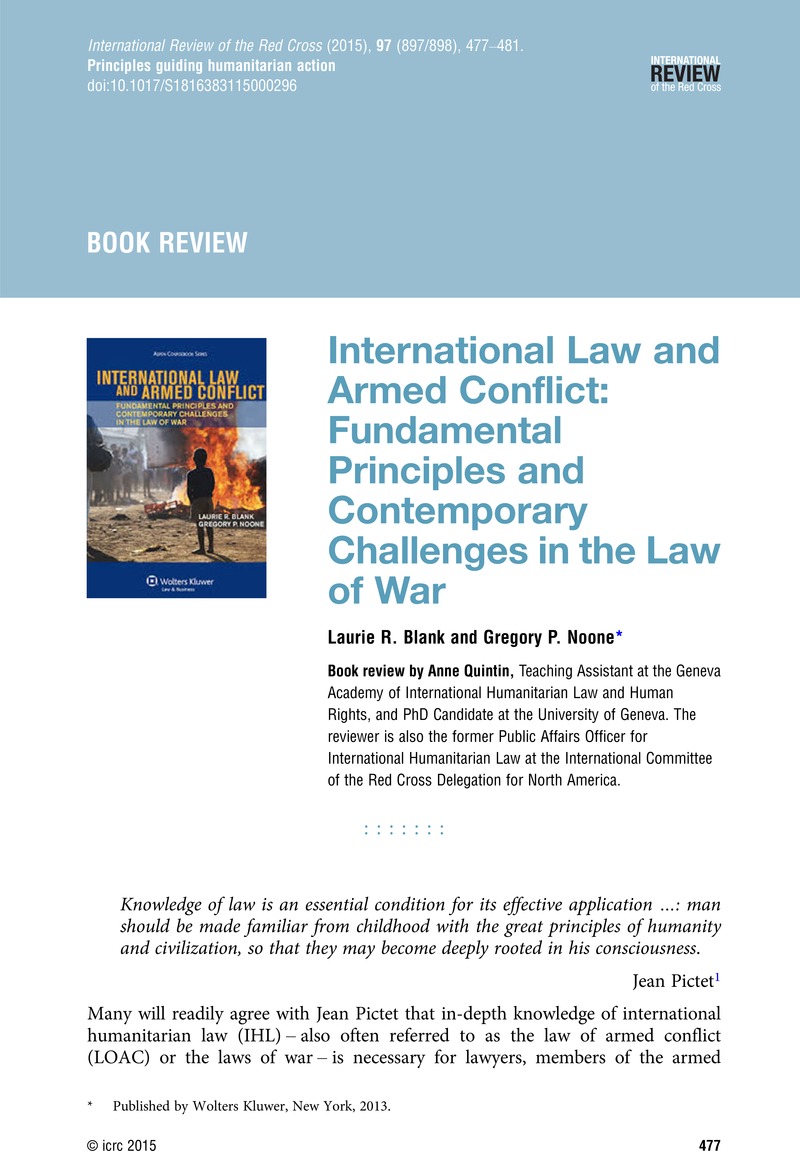Article contents
International Law and Armed Conflict: Fundamental Principles and Contemporary Challenges in the Law of WarLaurie R. Blank and Gregory P. Noone *
Published online by Cambridge University Press: 27 August 2015
Abstract

- Type
- Books and Articles
- Information
- International Review of the Red Cross , Volume 97 , Issue 897-898: Principles guiding humanitarian action , June 2015 , pp. 477 - 481
- Copyright
- Copyright © icrc 2015
References
1 Jean Pictet (ed.), Commentary on the Geneva Conventions of 12 August 1949, Vol. 1: Geneva Convention for the Amelioration of the Condition of the Wounded and Sick in Armed Forces in the Field, International Committee of the Red Cross (ICRC), Geneva, 1952, p. 348.
2 Indeed, the book is structured as follows: Part I, “Why” (looks at the basic principles and the history of IHL); Part II, “What and When” (includes chapters on the definition of armed conflict, the classification of conflicts, and occupation); Part III, “Who” (with clear chapters on combatants and civilians, followed by a chapter on battlefield status in NIAC); Part IV, “How” (mainly split into three chapters dealing with conduct of hostilities); Part V, “Implementation and Enforcement”.
3 International Law and Armed Conflict, Preface, p. xxiv.
4 ICTY, Prosecutor v. Tadić, Case No. IT-94-1, Decision on Defence Motion for Interlocutory Appeal on Jurisdiction, 2 October 1995, reproduced in International Law and Armed Conflict, pp. 93–96, 137–138, 155–156, 593–598; ICTY, Prosecutor v. Tadić, Case No. IT-94-1-T, Judgment, 7 May 1997, reproduced in International Law and Armed Conflict, pp. 107–110; ICTY, Prosecutor v. Tadić, Case No. IT-94-1-A, Appeals Judgment, 15 July 1999, reproduced in International Law and Armed Conflict, pp. 139–143, 286–288.
5 ICJ, Legal Consequences of the Construction of a Wall in the Occupied Palestinian Territory, Advisory Opinion, ICJ Reports, 9 July 2004, pp. 136, 215, reproduced in International Law and Armed Conflict, pp. 30–31.
6 US Supreme Court, Hamdan v. Rumsfeld, 548 US 557, 2006, reproduced in International Law and Armed Conflict, pp. 162–164.
7 Tribunal Militaire (Belgium Military Court), Ministre Public et Centre pour l'égalité des chances et la lutte contre le racisme c. C. et B., Journal des Tribunaux, 4 April 1998, p. 286, reproduced in International Law and Armed Conflict, p. 119–121.
8 Colombian Constitutional Court, Constitutional Review of Additional Protocol II, Ruling C-225/95, Re: File No. LAT-040, reproduced in International Law and Armed Conflict, pp. 48–49.
9 International Law and Armed Conflict, Preface, p. xxiv.
10 Ibid., p. 350, para. 8.
11 Ibid., Chapter 9, “Battlefield Status in Non-International Armed Conflict”, Part C, “Standards for Detention in NIAC”, pp. 386–392.
12 Ibid., Chapter 7, “Combatants”, pp. 235–240.
13 Ibid., Chapter 7, “Combatants”, Part C, “Prisoners of War: Purposes and Protection”, pp. 255–276.
14 Ibid., Chapter 6, “The Law of Belligerent Occupation”, pp. 196–198.
15 Ibid., Preface, p. xxxix.
- 1
- Cited by




